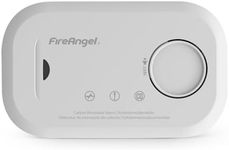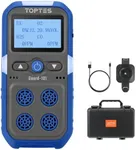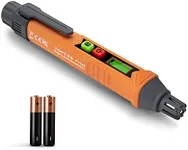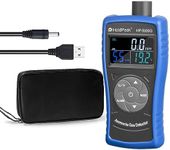Buying Guide for the Best Gas Detectors
When choosing a gas detector, it's crucial to understand the environment in which it will be used and the specific gases you need to detect. Gas detectors are essential for ensuring safety in environments where harmful gases may be present. They can be used in industrial settings, laboratories, or even at home. The right gas detector will alert you to the presence of dangerous gases, allowing you to take necessary precautions. To make an informed decision, consider the key specifications that determine the functionality and suitability of a gas detector for your needs.Type of Gas DetectedThis specification indicates which gases the detector can identify. It's important because different environments may have different gas hazards. Common gases include carbon monoxide, methane, propane, and hydrogen sulfide. Detectors can be single-gas or multi-gas. Single-gas detectors are suitable if you are concerned about one specific gas, while multi-gas detectors are ideal for environments where multiple gases may be present. Choose based on the specific gases you need to monitor in your environment.
Detection RangeThe detection range refers to the concentration levels of gas that the detector can measure. This is crucial for ensuring the detector can identify both low and high concentrations of gas. Detection ranges are usually measured in parts per million (ppm) or percentage of volume. For environments where even low levels of gas can be dangerous, a detector with a low detection range is necessary. Conversely, for environments where higher concentrations are expected, ensure the detector can handle those levels.
Sensor TypeThe sensor type determines how the gas is detected. Common sensor types include electrochemical, infrared, and catalytic bead sensors. Each type has its strengths; for example, electrochemical sensors are often used for toxic gases, while infrared sensors are good for detecting hydrocarbons. Choose a sensor type based on the specific gases you need to detect and the environment in which the detector will be used.
Response TimeResponse time is the duration it takes for the detector to register the presence of gas and alert the user. This is important for safety, as quicker response times mean faster alerts to potential dangers. Response times are typically measured in seconds. For high-risk environments, a detector with a fast response time is essential to ensure immediate action can be taken.
Alarm SystemThe alarm system is how the detector alerts you to the presence of gas. This can include audible alarms, visual indicators, or vibration alerts. The importance lies in ensuring you are promptly and effectively notified of any danger. Consider the environment where the detector will be used; for noisy areas, a visual or vibration alert might be more effective, while in quieter settings, an audible alarm could suffice.
Power SourceThe power source of a gas detector can be battery-operated or plugged into a power supply. This is important for ensuring the detector remains operational at all times. Battery-operated detectors offer portability and are useful in areas without power access, but require regular battery checks. Plug-in detectors are more suitable for fixed locations where continuous power is available. Choose based on the location and mobility needs of your gas detection requirements.
Durability and Environmental SuitabilityDurability refers to the detector's ability to withstand environmental conditions such as temperature, humidity, and physical impact. This is crucial for ensuring the detector functions correctly in the intended environment. Detectors designed for industrial use may be more robust and resistant to harsh conditions, while those for home use may not need such features. Consider the specific conditions of your environment to choose a detector that will remain reliable and effective.
















